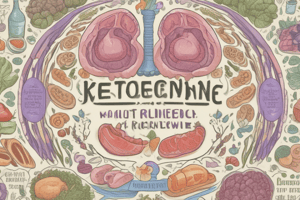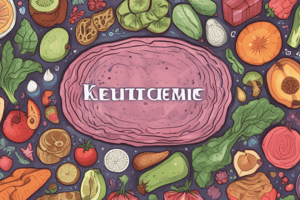Podcast
Questions and Answers
What was the primary goal of introducing the ketogenic diet in the 1990s?
What was the primary goal of introducing the ketogenic diet in the 1990s?
- To cure epilepsy in children with Down syndrome
- To provide a sustainable option for children with uncontrolled seizures (correct)
- To reduce the side effects of epilepsy medications
- To promote cell replication in brain cells
Why is the ketogenic diet a desirable option for certain children with epilepsy?
Why is the ketogenic diet a desirable option for certain children with epilepsy?
- It is a quick fix for seizures
- It provides a potent antiepileptic effect and is a sustainable option (correct)
- It is more accessible than prescribed medications
- It is a non-invasive treatment for epilepsy
What is the main difference between the classic ketogenic diet and other types of ketogenic diets?
What is the main difference between the classic ketogenic diet and other types of ketogenic diets?
- The level of ketoacidosis induced (correct)
- The age group it is suitable for
- The type of food used in the diet
- The duration of fasting required
What is the primary reason why the ketogenic diet cannot be sustained in the long term?
What is the primary reason why the ketogenic diet cannot be sustained in the long term?
What is a characteristic of brain cells?
What is a characteristic of brain cells?
What is the term used to describe the metabolic state induced by the ketogenic diet?
What is the term used to describe the metabolic state induced by the ketogenic diet?
What is the primary clinical benefit of the ketogenic diet?
What is the primary clinical benefit of the ketogenic diet?
What is a limitation of the classic ketogenic diet?
What is a limitation of the classic ketogenic diet?
What is the primary function of LKB1 in regulating the number of mitochondria and ATP generation?
What is the primary function of LKB1 in regulating the number of mitochondria and ATP generation?
What is the main difference between the standard ketogenic diet (SKD) and the cyclical ketogenic diet (CKD)?
What is the main difference between the standard ketogenic diet (SKD) and the cyclical ketogenic diet (CKD)?
What is the purpose of consuming dietary protein supplements in the Targeted Ketogenic Diet (TKD)?
What is the purpose of consuming dietary protein supplements in the Targeted Ketogenic Diet (TKD)?
What is the main benefit of the Cyclical Ketogenic Diet (CKD) over the Standard Ketogenic Diet (SKD)?
What is the main benefit of the Cyclical Ketogenic Diet (CKD) over the Standard Ketogenic Diet (SKD)?
What is the primary source of energy in the Standard Ketogenic Diet (SKD)?
What is the primary source of energy in the Standard Ketogenic Diet (SKD)?
What is the purpose of exercising on an empty stomach without carbohydrate supplementation in the Targeted Ketogenic Diet (TKD)?
What is the purpose of exercising on an empty stomach without carbohydrate supplementation in the Targeted Ketogenic Diet (TKD)?
What is the role of OXPHOS in the development of neural stem cells?
What is the role of OXPHOS in the development of neural stem cells?
What is the main limitation of the Standard Ketogenic Diet (SKD)?
What is the main limitation of the Standard Ketogenic Diet (SKD)?
What is the purpose of the Cyclical Ketogenic Diet (CKD)?
What is the purpose of the Cyclical Ketogenic Diet (CKD)?
What is the role of AMPK in regulating the number of mitochondria and ATP generation?
What is the role of AMPK in regulating the number of mitochondria and ATP generation?
What is the primary consequence of frequent exercise training without carbohydrate supplementation?
What is the primary consequence of frequent exercise training without carbohydrate supplementation?
What is the primary benefit of a targeted ketogenic diet (TKD) for athletes?
What is the primary benefit of a targeted ketogenic diet (TKD) for athletes?
What is the recommended ratio for a high-protein ketogenic diet?
What is the recommended ratio for a high-protein ketogenic diet?
What is the primary goal of a high-protein ketogenic diet in growing children?
What is the primary goal of a high-protein ketogenic diet in growing children?
What is the effect of a low-protein diet on mean life, according to animal studies?
What is the effect of a low-protein diet on mean life, according to animal studies?
What is the primary characteristic of classical ketosis, according to Miranda?
What is the primary characteristic of classical ketosis, according to Miranda?
What is the potential benefit of reproducing ketosis using few genera of bacteria?
What is the potential benefit of reproducing ketosis using few genera of bacteria?
What is the primary difference between a classical ketogenic diet and a modified Atkins diet?
What is the primary difference between a classical ketogenic diet and a modified Atkins diet?
What is the primary benefit of using a standard well-formulated nondietary proteinogenic ketogenic diet for metabolically healthy individuals?
What is the primary benefit of using a standard well-formulated nondietary proteinogenic ketogenic diet for metabolically healthy individuals?
What is the primary purpose of a virtually carb-free oral glucose tolerance testing solution?
What is the primary purpose of a virtually carb-free oral glucose tolerance testing solution?
Flashcards are hidden until you start studying
Study Notes
Ketogenic Diet and Epilepsy
- The ketogenic diet was introduced to maintain ketosis, a metabolic state that helps curb seizures in children with epilepsy, particularly those with uncontrolled seizures.
- The diet has a continuous and potent antiepileptic effect on children and adolescents with uncontrolled seizures.
- It is a desirable and sustainable option for those who experience intolerable side effects from epilepsy medications or have limited access to effective medications.
Types of Ketogenic Diets
Standard Ketogenic Diet (SKD)
- The SKD was first designed for epilepsy patients in the 1920s.
- A typical SKD meal contains 3-4g of fats, 0.8-1g of proteins, and 1g of carbohydrates per gram of carbohydrates, providing up to 90% of energy in fats.
- The diet has limitations, including food type restrictions and potential nutrient deficiencies, such as selenium, iodine, and zinc.
Cyclical Ketogenic Diet (CKD)
- The CKD represents an innovative approach to the ketogenic diet, integrating diet cycles to maintain nutritional support and control seizures.
- The diet allows for a balance between antiepileptic effects and food preference, making it more appealing to patients and families.
- It provides an opportunity to relieve dietary restrictions on carbohydrate restriction and improve compliance with the diet.
Targeted Ketogenic Diet (TKD)
- The TKD is suitable for individuals who require high-intensity exercise, such as sprinting, weightlifting, and jumping.
- The diet involves briefly lowering muscle glycogen levels through exercise, followed by rapid replenishment of muscle glycogen through insulin-independent metabolic pathways.
- It optimizes muscle glycogen levels, muscle performance, mental clarity, and long-term muscle growth for highly customized sports participation.
High-Protein Ketogenic Diet
- The high-protein ketogenic diet requires strict counseling to be effective.
- The diet should guarantee coverage of growth requirements and bone health for growing children, with a minimum of 80% of the recommended dietary allowance and at least 10g of carbohydrates per day.
- The diet has been shown to have a positive effect on animals, but its long-term effects on humans are still unknown.
Studying That Suits You
Use AI to generate personalized quizzes and flashcards to suit your learning preferences.




